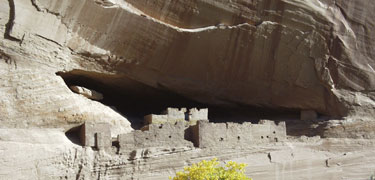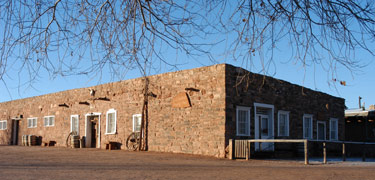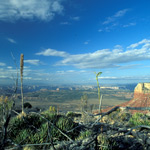Canyon De Chelly National Monument

Reflecting one of the longest continuously inhabited landscapes of North America, the cultural resources of Canyon de Chelly include distinctive architecture, artifacts, and rock imagery while exhibiting remarkable preservation integrity that provides outstanding opportunities for study and contemplation. Canyon de Chelly also sustains a living community of Navajo people, who are connected to a landscape of great historical and spiritual significance. Canyon de Chelly is unique among National Park service units, as it is comprised entirely of Navajo Tribal Trust Land that remains home to the canyon community. NPS works in partnership with the Navajo Nation to manage park resources and sustain the living Navajo community.
For more detailed information please click on one of the links below:
|
|
|
Casa Grande Ruins National Monument

Casa Grande Ruins National Monument preserves an ancient Hohokam farming community and "Great House." Created as the nation's first archeological reserve in 1892, the site was declared a National Monument in 1918 "in order that better provision may be made for the protection, preservation and care of the ruins and the ancient buildings and other objects of prehistoric interest thereon."
For more detailed information please click on one of the links below:
|
|
|
Chiricahua National Monument

A "Wonderland of Rocks" is waiting for you to explore at Chiricahua National Monument. This forest of rock spires was eroded from layers of ash deposited by the Turkey Creek Volcano eruption 27 million years ago. The 8 mile paved scenic drive and 18 miles of day-use hiking trails provide opportunities to discover the beauty, natural sounds, and inhabitants of this 11,985 acre site. Visit the Faraway Ranch Historic District to discover more about the people who have called this area home: Chiricahua Apaches, Buffalo Soldiers, Erickson and Stafford families.
For more detailed information please click on one of the links below:
|
|
|
Coronado National Monument

Coronado National Memorial commemorates and interprets the significance of Francisco Vasquez de Coronado's expedition and the resulting cultural influences of 16th century Spanish colonial exploration in the Americas. The Memorial preserves and interprets the natural and human history of the area for the benefit and enjoyment of present and future generations.
For more detailed information please click on one of the links below:
|
|
|
Fort Bowie National Historic Site

Fort Bowie commemorates the bitter conflict between Chiricahua Apaches and the U.S. military - a lasting monument to the bravery and endurance of U.S. soldiers in paving the way for settlement and the taming of the western frontier. It provides insight into a "clash of cultures," a young nation in pursuit of "manifest destiny," and the hunter/gatherer society fighting to preserve its existence.
For more detailed information please click on one of the links below:
|
|
|
Glen Canyon National Recreation Area

Encompassing over 1.2 million acres, Glen Canyon National Recreation Area (NRA) offers unparalleled opportunities for water-based & backcountry recreation. The recreation area stretches for hundreds of miles from Lees Ferry in Arizona to the Orange Cliffs of southern Utah, encompassing scenic vistas, geologic wonders, and a vast panorama of human history.
For more detailed information please click on one of the links below:
|
|
|
Grand Canyon National Park

A powerful and inspiring landscape, the Grand Canyon overwhelms our senses through its immense size. Unique combinations of geologic color and erosional forms decorate a canyon that is 277 river miles (446km) long, up to 18 miles (29km) wide, and a mile (1.6km) deep. The Grand Canyon is considered one of the natural wonders of the world largely because of its natural features. The exposed geologic strata, layer upon layer, rise over a mile above the river, representing one of the most complete records of geological history that can be seen anywhere in the world.
For more detailed information please click on one of the links below:
|
|
|
Hohokam Pima National Monument
Hohokam Pima National Monument was authorized by Congress on October 21, 1972, to protect an ancient Hohokam village known today as "Snaketown." Excavations in the 1930's and again in the 1960's revealed the site was inhabited from about 300 BC to around 1200 AD and may have had up to 2,000 inhabitants. Following the last excavations, the site was completely recovered with earth, leaving nothing visible above ground.
The Monument is located on the Gila River Indian Reservation and is under tribal ownership. The Gila River Indian Community has decided not to open the extremely sensitive area to the public. There is no park brochure, passport stamp, picture stamp or other free literature available.
For further information, two books are highly recommended: Excavations at Snaketown, Material Culture, by Harold S. Gladwin, 1965; and The Hohokam: Desert Farmers and Craftsmen, by Emil Haury, 1978.
|
|
|
Hubbell Trading Post National Historic Site

Feel the old wooden floor give slightly and squeak beneath your feet as you enter the oldest, continuously operating trading post on the Navajo Nation. As your eyes adjust to the dim lighting of the "bullpen" you might catch the trader negotiating a deal with a Native American artist for their art. You will experience history first hand at Hubbell Trading Post NHS.
For more detailed information please click on one of the links below:
|
|
|
Juan Bautista de Anza National Historic Trail

"Everyone mount up!" This became a familiar call from Spanish Captain Juan Bautista de Anza. In 1776, as Americans fought for their independence in the East, Anza led almost 300 people over 1200 miles to settle Alta California. It was the first overland route established to connect New Spain with San Francisco. Walk in their footsteps from Nogales, Arizona to San Francisco, California.
For more detailed information please click on one of the links below:
|
|
|
Lake Mead National Recreation Area

Lake Mead National Recreation Area offers a wealth of things to do and places to go year-round. Its huge lakes cater to boaters, swimmers, sunbathers, and fishermen while its desert rewards hikers, wildlife photographers, and roadside sightseers. It is also home to thousands of desert plants and animals, adapted to survive in an extreme place where rain is scarce and temperatures soar.
For more detailed information please click on one of the links below:
|
|
|
Montezuma Castle National Monument

Gaze through the windows of the past into one of the best preserved cliff dwellings in North America. This 20 room high-rise apartment, nestled into a towering limestone cliff, tells a 1,000 year-old story of ingenuity and survival in an unforgiving desert landscape. Marveling at this enduring legacy of the Sinagua culture reveals a people surprisingly similar to ourselves.
For more detailed information please click on one of the links below:
|
|
|
Navajo National Monument

Navajo National Monument preserves three intact cliff dwellings of the Ancestral Puebloan people. A visitor center, museum, three short self-guided trails, two small campgrounds, and a picnic area provide service to travelers that make the trek to this remote hamlet.
For more detailed information please click on one of the links below:
|
|
|
Old Spanish National Historic Trail

Take a journey across the Southwest on the Old Spanish National Historic Trail between Santa Fe and Los Angeles for history, culture, and scenic beauty.
For more detailed information please click on one of the links below:
|
|
|
Organ Pipe Cactus National Monument

Organ Pipe Cactus National Monument celebrates the life and landscape of the Sonoran Desert. In this desert wilderness, you may drive a lonely road, hike a backcountry trail, camp beneath a clear desert sky, marvel at magnificent cactus, or soak in the warmth and beauty of the Southwest.
For more detailed information please click on one of the links below:
|
|
|
Parashant National Monument

Grand Canyon Parashant's natural splendor provides a sense of solitude to those who venture into its isolated domain. Located on the edge of one of the most beautiful places on earth, the Grand Canyon, the Monument's expansive landscape encompasses a chronicle of natural and cultural history.
For more detailed information please click on one of the links below:
|
|
|
Petrified Forest National Park

With one of the world's largest and most colorful concentrations of petrified wood, multi-hued badlands of the Painted Desert, historic structures, archeological sites, and displays of 225 million year old fossils, this is a surprising land of scenic wonders and fascinating science.
For more detailed information please click on one of the links below:
|
|
|
Pipe Spring National Monument

American Indians, Mormon pioneers, plants, animals, and others have depended on the life-giving water found at Pipe Spring.
For more detailed information please click on one of the links below:
|
|
|
Saguaro National Park

Enormous cacti, silhouetted by the setting sun, for most of us the Giant Saguaro is the universal symbol of the American West. And yet, these majestic plants are only found in a small portion of the United States. Saguaro National Park protects some of the most impressive forests of these sub-tropical giants, on the edge of the modern City of Tucson.
For more detailed information please click on one of the links below:
|
|
|
Sunset Crater Volcano National Monument

Sunset Crater Volcano was born in a series of eruptions sometime between 1040 and 1100. Powerful explosions profoundly affected the lives of local people and forever changed the landscape and ecology of the area. Lava flows and cinders still look as fresh and rugged as the day they formed. But among dramatic geologic features, you'll find trees, wildflowers, and signs of wildlife – life returns.
For more detailed information please click on one of the links below:
|
|
|
Tonto National Monument

Situated within rugged terrain in the northeastern part of the Sonoran Desert, these well-preserved cliff dwellings were occupied during the 13th, 14th, and early 15th centuries.
For more detailed information please click on one of the links below:
|
|
|
Tumacacori National Historical Park

Tumacácori NHP protects three Spanish colonial mission ruins in southern Arizona: Tumacácori, Guevavi, and Calabazas. The adobe structures are on three sites, with a visitor center at Tumacácori. These missions are among more than twenty established in the Pimería Alta by Father Kino and other Jesuits, and later expanded upon by Franciscan missionaries.
For more detailed information please click on one of the links below:
|
|
|
Tuzigoot National Monument

Crowning a desert hilltop is an ancient pueblo. From a roof top a child scans the desert landscape for the arrival of traders, who are due any day now. What riches will they bring? What stories will they tell? Will all of them return? From the top of the Tuzigoot Pueblo it is easy to imagine such an important moment. Tuzigoot is an ancient village or pueblo built by a culture known as the Sinagua. The pueblo consisted of 110 rooms including second and third story structures. The first buildings were built around A.D. 1000. The Sinagua were agriculturalists with trade connections that spanned hundreds of miles. The people left the area around 1400. The site is currently comprised of 42 acres.
For more detailed information please click on one of the links below:
|
|
|
Walnut Canyon National Monument

Walk in the footsteps of people who lived at Walnut Canyon more than 700 years ago. Peer into their homes, cliff dwellings built deep within canyon walls. The presence of water in a dry land made the canyon rare and valuable to its early human inhabitants. It remains valuable today as habitat for plants and animals. See for yourself on trails along the canyon rim and into the depths.
For more detailed information please click on one of the links below:
|
|
|
Wupatki National Monument

Less than 800 years ago, Wupatki Pueblo was the largest pueblo around. It flourished for a time as a meeting place of different cultures. Yet this was one of the warmest and driest places on the Colorado Plateau, offering little obvious food, water, or comfort. How and why did people live here? The builders of Wupatki and nearby pueblos have moved on, but their legacy remains.
For more detailed information please click on one of the links below:
|
|
|
Yuma Crossing National Heritage Area

Located in the southwestern corner of Arizona, Yuma served as a vital crossing of the Lower Colorado River in the 19th Century and an innovator of water management and desert agriculture in the 20th Century. The Heritage Area’s mission is to conserve and enhance the Colorado River, the historic downtown, but most importantly, its sense of place in a rapidly changing community.
For more detailed information please click on one of the links below:
|
|
|
























